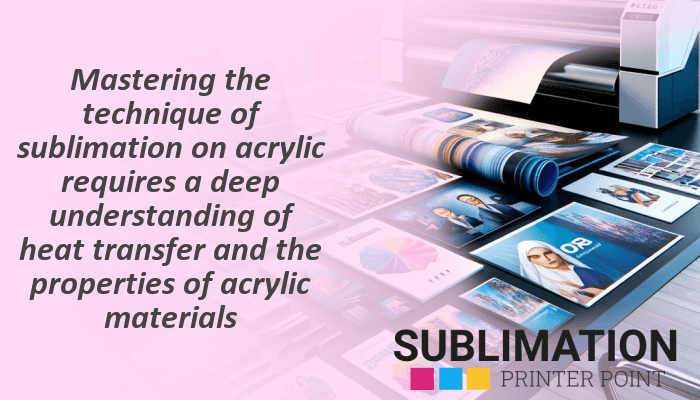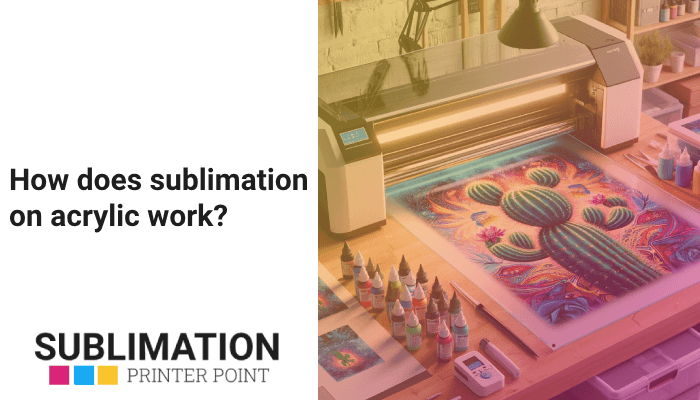Learn about the intriguing topic of sublimation on acrylic, a process that combines heat, pressure, and specialized ink to create vibrant, durable prints on acrylic surfaces.
Through the use of heat, specialized ink is transformed from solid to gas during the sublimation process on acrylic, avoiding the liquid phase. Prints produced with this method are durable and of excellent definition on acrylic surfaces. A heat press, sublimation paper, ink, and dye-sublimation printer are essential parts. Acrylic is the perfect material for this method because of its clear surface and ability to withstand heat. The outcome is a vivid, long-lasting print that is impervious to fading and harm.
- Sublimation on acrylic involves transitioning ink from solid to gas using heat, creating vibrant prints on acrylic surfaces.
- The process requires a dye-sublimation printer, sublimation ink, sublimation paper, and a heat press.
- Acrylic is a preferred material due to its heat-resistant properties and clear surface.
- The final product is a high-definition, long-lasting print that is resistant to fading and damage.
| Component | Description | Role in Sublimation Process |
|---|---|---|
| Dye-Sublimation Printer | A printer that utilizes heat to transfer dye onto materials such as plastic, card, paper, or fabric. | Transfers the desired image onto the sublimation paper using the sublimation ink. |
| Sublimation Ink | Specially formulated ink for sublimation. | Transforms into a gas when heat and pressure are applied, permeating the surface of the material being printed on. |
| Sublimation Paper | Paper used as a carrier for the sublimation ink. | Ensures the ink is accurately transferred to the print surface. |
| Heat Press | A device that applies heat and pressure to the sublimation paper. | Causes the ink to transform into a gas, which then permeates the printing surface, creating a high-quality, durable print. |
| Acrylic | A durable, clear, and versatile material used in many sublimation projects. | Provides a smooth and clear surface for image transfer. Its heat-resistant properties make it ideal for the high temperatures involved in the sublimation process. |
This table gives a quick summary of the main elements, their functions, and explanations that go into the sublimation process.
What is the sublimation process?
Sublimation is an intriguing process in which a material bypasses the liquid phase and goes straight from a solid state into a gaseous state. In printing, this method is used to print graphics on a variety of substrates, such as acrylic. In the printing industry, the sublimation process is revolutionary because it produces prints with sharp colors, excellent definition, and durability. It’s important to realize that the proper ratio of heat, sublimation paper, and ink is critical to the process’ performance.
What are the key components of sublimation printing?
The intricate process of sublimation printing necessitates the harmonious operation of multiple essential elements. A heat press, sublimation paper, ink, and dye-sublimation printer are the main components. Using the sublimation ink, the printer is in charge of printing the desired picture onto the sublimation paper. After that, the ink changes into a gas and permeates the printing surface due to the heat and pressure applied by the heat press, producing a long-lasting, excellent print.
How does dye-sublimation printers work?
The key component of the sublimation process are dye-sublimation printers. They work by applying heat to materials like cloth, paper, plastic, or cards to transfer dye to them. Using a heating element, the printers sublimate the solid dye particles into a gas, which is then diffused onto the printing area and solidifies. As a consequence, you get a continuous-tone print that is glossy and durable.
Were you aware? Typically, the ideal temperature range for sublimation on acrylic is 182째C (360째F) to 204째C (400째F). Using a heat press that allows for exact temperature control, such as EasyPress or AutoPress, is essential to avoid damaging the acrylic due to overheating.
What role does sublimation ink and sublimation paper play in the process?
Elevation Paper and ink are essential components of the sublimation process. The paper is printed using a sublimation-specific ink that has been properly blended. The ink becomes a gas and penetrates the surface of the item being printed on when pressure and heat are applied. The ink is accurately transported to the print surface thanks to the paper’s role as a carrier. The end print quality can be greatly impacted by the caliber of the paper and ink.
What is the role of acrylic in sublimation printing?
An essential component of sublimation printing is acrylic. Many sublimation projects use acrylic as their chosen medium because of its strength, clarity, and adaptability. It offers a clean, flat surface for image transfer and can be utilized in sheets or blank form. Acrylic is the perfect material for the high temperatures required in the sublimation process because of its heat-resistant qualities.
What are acrylic sheets and acrylic blanks?
Materials like acrylic sheets and blanks are widely used in the sublimation business. Transparent thermoplastic homopolymers with a reputation for strength and adaptability are acrylic sheets. They are appropriate for a wide range of applications because they may be cut into different sizes and forms. Conversely, acrylic blanks are pre-cut acrylic pieces made for particular uses. They are available in an array of forms and dimensions, all of which can be personalized by sublimation printing.
Why is acrylic preferred for sublimation techniques?
Acrylic’s many beneficial qualities make it a preferred material for sublimation methods. Its durability guarantees the lifespan of the printed artwork, while its transparency enables vivid, high-definition printing. Additionally, acrylic is perfect for the high temperatures required for sublimation due to its heat resistance. Because of its adaptability, it can be used for a variety of purposes, including decorative items and signage.
Advice: Before printing your image on sublimation paper, make sure it is mirrored. This guarantees the accurate appearance of the final print on the acrylic. Numerous guides on how to accomplish this may be found on websites such as Google Sponsor or YouTube.
How does the heat press interact with acrylic during image transfer?
Especially when using acrylic, the heat press is vital to the sublimation process. It causes the ink to turn into a gas by applying pressure and heat to the sublimation paper. The acrylic surface is then penetrated by this gas, which solidifies to create a vivid, long-lasting print. Overheating the acrylic can cause damage, thus the heat press needs to be precisely calibrated to guarantee that the proper pressure and temperature are delivered.
How does sublimation on acrylic affect print quality and durability?
Print quality and durability are greatly improved by sublimation on acrylic. Vibrant, high-definition prints that are resilient to fading and damage can be produced using this procedure. The acrylic surface is penetrated by the ink, producing a print that is durable and aesthetically pleasing. Because of this, sublimation on acrylic is a great option for situations where quality and longevity are crucial.
What is the impact of sublimation on color management and graphic design?
Sublimation has a significant effect on graphic design and color management. The method makes it possible to produce vivid, full-color prints with outstanding clarity and detail. Compared to other printing techniques, sublimation produces more vivid and dynamic colors, giving designers more artistic freedom. Furthermore, sublimation opens up a world of possibilities for graphic designers by making it possible to print intricate patterns and graphics.
How does sublimation coating enhance print durability on acrylic?
On acrylic, sublimation coating is essential for improving print permanence. The coating serves as a barrier, preserving the print from outside influences including UV radiation, abrasions, and normal wear and tear. This increases the print’s overall longevity by guaranteeing that it stays bright and intact for a longer amount of time. Additionally, the coating improves the sublimation ink’s adherence to the acrylic surface, giving the finish a smoother, more polished appearance.
What are the benefits of digital printing on acrylic displays?
The use of digital printing on acrylic displays has many advantages. It makes it possible to produce vivid, high-definition prints that are hard to fade or break. Large-scale production is best suited for this method because it is also rapid and effective. Moreover, digital printing gives designers more creative freedom to create intricate patterns and designs. Because of this, it’s a well-liked option for producing visually striking displays and signage.

What are the applications of sublimation on acrylic?
Applications for sublimation on acrylic are numerous. It is frequently employed in the production of ornamental objects, exhibitions, and signage. The method is perfect for applications where quality and longevity are crucial since it produces vivid, high-definition prints that are resistant to fading and damage. Sublimation on acrylic offers countless possibilities, from personalized gifts to store displays.
What are some popular sublimation products made with acrylic?
Acrylic is used in the production of many well-known sublimation items. These consist of ornamental objects, displays, photo blocks, keychains, and signage. Acrylic signage is frequently utilized in retail and commercial settings, and acrylic photo blocks are a popular option for showcasing treasured memories. For a variety of sublimation goods, acrylic is a preferred material due to its strength and adaptability.
How are custom acrylic prints created using sublimation?
Using sublimation, one can create custom acrylic prints by first printing the desired picture with sublimation ink onto sublimation paper. After that, the paper is put on the acrylic surface, and pressure and heat are applied using a heat press. As a result, the ink turns into a gas that penetrates the acrylic surface and solidifies to create a vivid, long-lasting print. The end product is a long-lasting and exquisitely designed personalized acrylic print.
What industries commonly use sublimation on acrylic?
Many different businesses frequently utilize sublimation on acrylic. For example, the retail sector frequently uses sublimation-created displays and acrylic signage. Sublimation on acrylic is frequently used in the hospitality sector for products like menu boards and room signage. The advertising, events, and interior design sectors are among the other industries that frequently use sublimation on acrylic.

